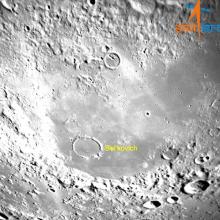Listen to today's episode of StarDate on the web the same day it airs in high-quality streaming audio without any extra ads or announcements. Choose a $8 one-month pass, or listen every day for a year for just $30.
You are here
Moon and Regulus
The Moon rattles a bit. The way it rattles can reveal details about how it’s put together, how it was born, and more. And scientists are pondering a network of instruments to listen in.
The Lunar Geophysical Network would consist of four robotic landers. Three of them would be on the hemisphere that always faces Earth, while the fourth would be on the farside. An orbiting satellite would relay its observations to Earth.
Each lander would carry a seismometer to listen for moonquakes. Astronauts left similar devices on the Moon decades ago, and they worked for years. They found that the Moon is much quieter than Earth, but it does rattle. A recent study of the quakes suggests that the Moon may be shrinking as it gets older and cooler.
Seismic waves from the quakes rattle through the Moon, bouncing off different layers. A network of listening devices could map those layers and learn what they’re made of.
Other instruments would measure the Moon’s temperature, and allow telescopes on Earth to precisely track “wobbles” in its rotation. Those details would help scientists piece together the Moon’s history.
To fly, the proposed mission will have to beat out other possible missions of exploration. If it does, it could head for the Moon in a few years.
For now, look for the Moon in the west at nightfall. The bright star Regulus, the “heart” of the lion, is close by, and stays close as they set in the wee hours of the morning.
Script by Damond Benningfield





